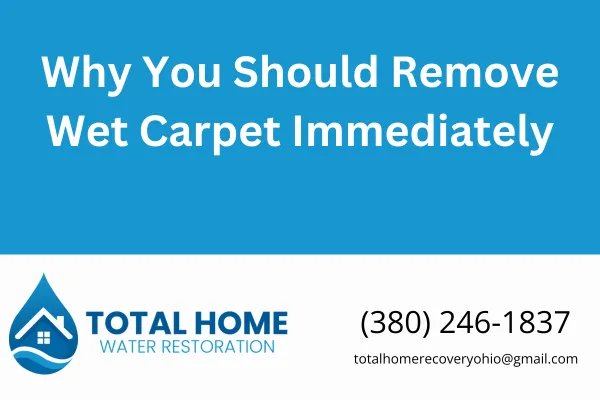
Why You Should Remove Wet Carpet Immediately
Why You Should Remove Wet Carpet Immediately
If your carpet just got soaked—whether from a burst pipe, sump pump failure, or roof leak—don’t wait and see if it dries. Wet carpet isn’t just uncomfortable; it’s dangerous for your home and your health.
I’ve seen too many homes around Grove City, Hilliard, and Columbus go from a minor water issue to full-blown mold remediation because someone waited “just a few days.” Here’s what every homeowner needs to know about wet carpet removal.
What Happens When Carpet Gets Wet?
Water quickly seeps through carpet fibers and into the pad underneath. That pad acts like a sponge. It holds moisture long after the surface looks dry.
Within Hours:
Odors start creeping in.
Bacteria begin multiplying.
Within 24–48 Hours:
Mold starts growing—fast.
The subfloor underneath (especially OSB or plywood) starts to swell.
After 72+ Hours:
Permanent damage to the subfloor and framing may occur.
You’re likely looking at mold remediation and possibly rebuilding part of the room.
Why Fast Carpet Removal Matters
The IICRC (our industry standard body) states in the S500 Standard for Professional Water Damage Restoration that porous materials like carpet and pad should be removed if they’ve been wet for more than 48 hours, especially if the water source was anything but clean (like rainwater, gray water, or sewage).
Leaving Carpet Can Lead To:
Mold Growth: Even on clean water losses, mold can start in 1–2 days.
Structural Rot: Wet carpet can damage the wood subfloor, leading to costly repairs.
Health Issues: Mold spores, bacteria, and allergens thrive in damp carpet.
Can You Save the Carpet?
Sometimes, yes—if we act quickly. If the water was clean and it’s been less than 24 hours, Total Home Water Restoration may be able to:
Extract the water
Lift the carpet and remove the pad
Dry and sanitize the subfloor
Reinstall the carpet with new pad
But if it's been longer or the water is contaminated, it's not worth the risk.
What We Do When You Call Us
At Total Home Water Restoration, here’s how we handle wet carpet situations:
Inspect and classify the damage (clean, gray, or black water)
Extract standing water using commercial-grade equipment
Remove and dispose of the carpet pad
Dry the subfloor with industrial air movers and dehumidifiers
Sanitize and deodorize to prevent mold and odor
Document everything for insurance (we work with all carriers)
Real Talk from the Job Site
We recently helped a homeowner in Westerville whose dishwasher line broke. They waited four days, hoping fans would dry it out. When we pulled the carpet, there was mold on the bottom of the pad and black spots already forming on the OSB subfloor.
We had to cut out part of the subfloor and do a full mold remediation. If we’d been called the same day? A simple pad replacement would’ve fixed it.
FAQ
How can I tell if the carpet is dry underneath?
You can’t, not without lifting it or using a moisture meter. Looks dry doesn’t mean is dry.
What if the water came from a clean source?
Even clean water becomes contaminated over time. Bacteria and mold don’t wait.
Can I just clean the carpet with a shop vac?
Not deep enough. The pad underneath traps moisture where your vac can’t reach.
Don’t Wait – Call Us Now
If your carpet is wet, call Total Home Water Restoration. We’re local, fast, and honest. We'll treat your home like it's our own.
📍 4141 Hoover Rd, Grove City, OH 43123
📞 380-246-1837
From Grove City to Dublin, Reynoldsburg to Worthington, we’ve got your back.
